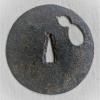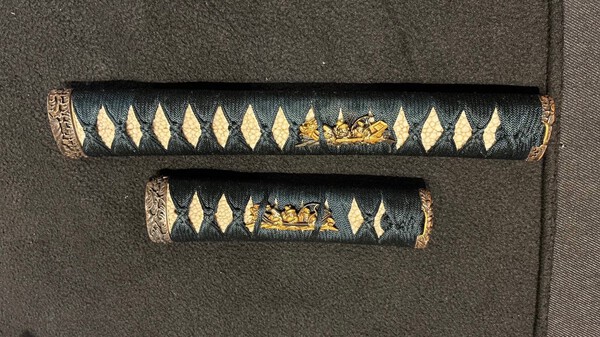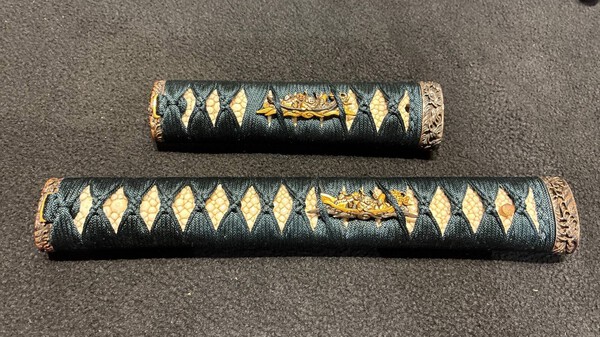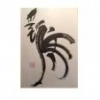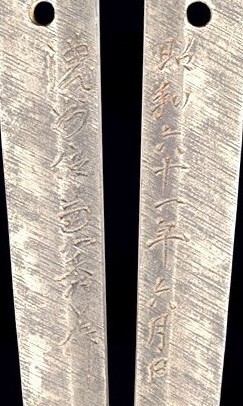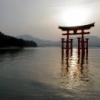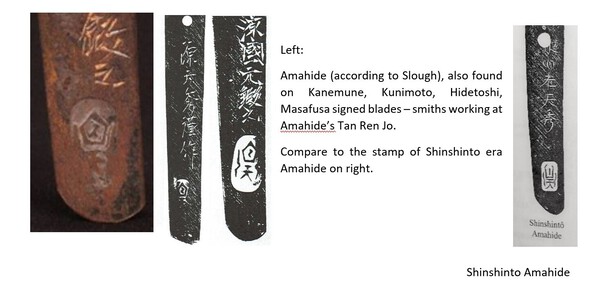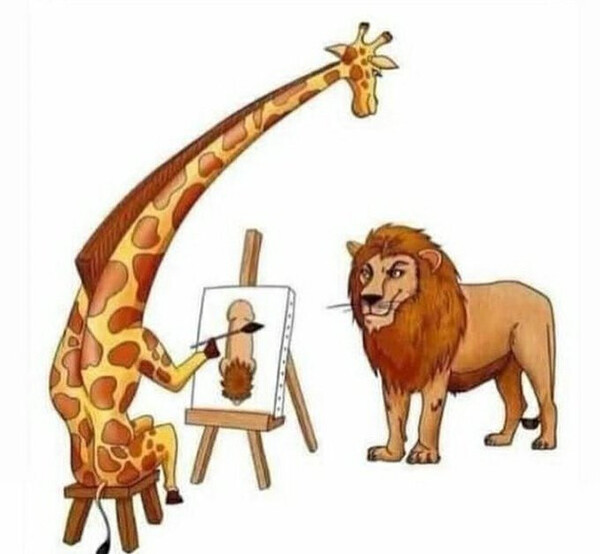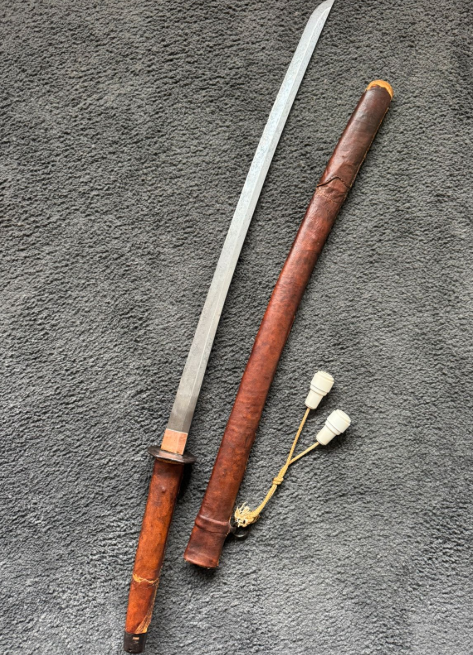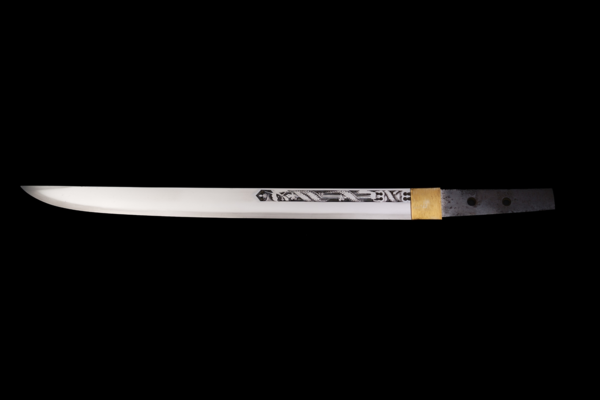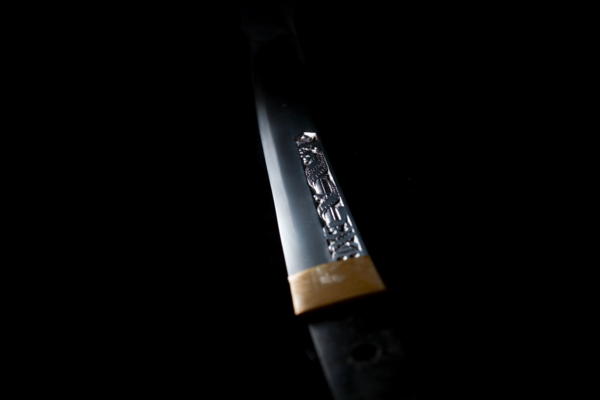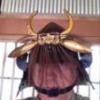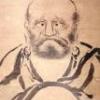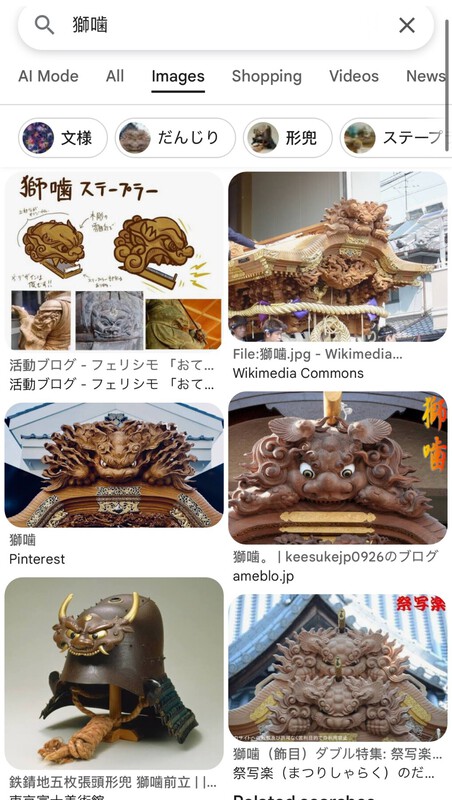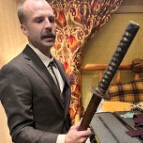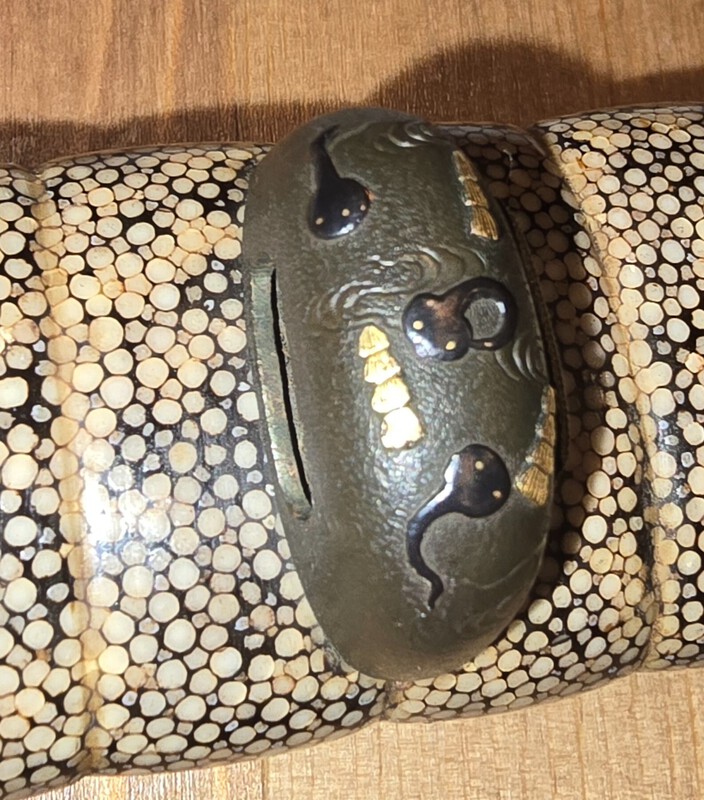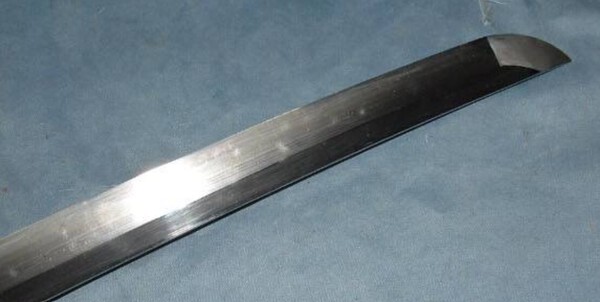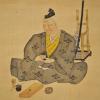Leaderboard
Popular Content
Showing content with the highest reputation on 10/09/2025 in all areas
-
5 points
-
3 points
-
2 points
-
Thank you Dirk, that sounds much more reasonable! What can we learn from that? Good translations can only be made with some competence in the subject!2 points
-
2 points
-
2 points
-
2 points
-
Well I'm glad I stumbled across that eBay listing. I learned something new and It’s cool to uncover details about these more obscure smiths.2 points
-
2 points
-
Yes. He, and/or his forge, had his own kokuin that is seen on his blades, but also on 4 other smiths that must have worked at the forge - Kanemune, Kunimoto, Hidetoshi, and Masafusa And yet, we also have one of his blades with an unknown stamp: And a couple blades with his Retired Servicemen's group, Koa Token Sha, kokuin: All this added to these stamped-mei blades!2 points
-
.."I felt a sense of shock from which I never recovered..." Exactly—this is what I hoped to touch upon earlier. Call it bottom-up processing, a first-order experience, epiphany, shock, ... or use Scotus's definition (props to Mushin—cut to the bone ); it is a visceral experience that happens to you, a unique connection between the object and the observer, the gaze outward becomes a gaze inward ("du gleichst dem Geist den du begreifst"). If this can be learned, it likely comes closest to the concept of "Ishin-denshin", where the teacher acts more as a catalyst for the student, setting their process of self-understanding into motion (or elevating it to a new level). (Perhaps this was the role Darcy played for some forum members; at least, I got the impression that he was a good soul.) Then, it seems to me that there is at least a second, very interesting central path of top-down processing: the study of primary and secondary literature, the field of quote assemblage, hearsay, and the translators and autistic data collectors and data enthusiasts (I have the utmost respect for them). But also, and most importantly, the realm of fiction, self-worth, and the social sphere—in short, chaos. The social sphere, in my view, distinguishes the question of aesthetics (i.e., mastery) from questions about for example the essence of time or love. Aesthetics can, and often does, quickly become a socially constructed product. It can be easily manipulated and stretched. In this regard, the social dimension in the question of what is considered beautiful seems particularly relevant in a collectivist country like Japan. I would also place the following contribution here: ..."Paul relates that Albert Yamanaka held the opinion: Noda Hankei's arrogance was responsible for the blunt gracelessness of his shapes." Objective influences fade into the background, and the value of a work / a blacksmith becomes closely linked to the behavior of the social actors of the time— as well as the market, critics, curators, collectors, dealers, ... The exchange relationships between these actors play a decisive role, as they create an informal socialization around rules, trends, and the language of the market. Such network effects, especially in Japan, play a crucial role in the development of a smith’s reputation and how it is perceived in the market, an aspect I’ve so far given too little attention to, but I hope to engage in more exchange about. Specific signals, like positive evaluations by experts (the Honami family and their repeated crises of trust), protégés, peers, provenance, and familial relationships, imply a higher value. Must a sword be of higher quality just because it was owned by a famous Daimyo? The status of a smith or an artwork is negotiated through such exchange processes. This means that if a blacksmith had a great need for recognition, the ability to stage himself and his skills, and gain the support of wealthy patrons, he would enter the annals of history. But the opportunities for a blacksmith to rise, cannot be seen as entirely equal or chance-driven. In my opinion, it is 100% likely that there were blacksmiths who were nonconformists, obsessed with pioneering spirit, ahead of their time, uncompromisingly realizing their own visions and abilities, but who fell out for example of favor with wealthy contemporaries, faded into obscurity, and whose works did not gain recognition because they lacked the positive influences of provenance or similar factors. The influence of actors within the social system is determined by their status, which is, in turn, affected by their interactions with associated actors. Status, thus, becomes a self-reinforcing process. For many collectors and art buyers, interacting with the social system serves primarily to elevate their own status (how much status matters and self-worth is also frequently observed in our forum when the discussion quickly leaves the subject matter and becomes emotional). Many interesting perspectives have been outlined so far, and I look forward to learning more. I’m eager to understand more about the technical intricacies. What are the key points in Paul R. Allman’s work?2 points
-
A little missive of mine from early 2023. Kanehide Gendaito Rinji questions1 point
-
1 point
-
Good question John. Any of your ideas might be the right one. They might have all been part of a batch order given to a particular sword shop to outfit and the numbering system might have been done by the sword shop. But anything is possible. Interesting that you identified a particular system on multiple blades!1 point
-
In the meantime, I've bought it (I just need to pick it up), so I think it's legal to display it here. After some searching online, I managed to find an exact copy. The tsuba and the marking on the tsuba are also the same. I don't think this is a field modification. Perhaps I bought a pig in a poke, in which case I'll just consider it a learning experience.1 point
-
1 point
-
Whale whiskers I have my doubts you will find. But the thread you are looking for is called jabara ito. Eg: https://www.namikawa-ltd.com/product/157 https://www.namikawa-ltd.com/product/1581 point
-
1 point
-
Chandler, I understood your post completely. This may be YOSHINDO-SENSEI's way to do it, but as I wrote, technically, it is not necessary to "soften" the steel for a new hardening process. It is not a "better" way, but causes scaling.1 point
-
Unfortunately I cannot identify a masterpiece amongst very good quality swords. I understand my limitations and as Reinhard wrote out so well about Japanese taste and appreciation points, I cannot achieve that understanding. I am limited to my own quite biased appreciation of swords. Just looked out my sword diaries and it seems I have seen 21 National Treasures, and to me it puzzled me as I couldn't even faintly remember all of them. Out of them only 3 swords were items that I immidiately thought that I personally see as masterpieces in my personal taste. Of course I think all National Treasures are masterpieces it is just that I lack understanding and judgement to understand them fully. And many might think that of course they will the 3 ōdachi... well yes an no. I do think the mumei ōdachi attributed to Bungo Tomoyuki is extremely well made for such a huge sword but is it unique when compared to other historical ōdachi. So the 3 most remarkable National Treasures that I have personally seen so far are Tomomitsu ōdachi, Nagayoshi ōdachi and Tokuzenin Sadamune wakizashi. I was also thinking about Kosetsu Samonji tachi but when I spent a lot more time looking at Jūyō Bunkazai tachi by Kanemitsu in the same room, I don't think personally I would classify it as high as the other 3 on my personal list. Fukuyama Art Museum is a crazy place, they had lent 2 of their National Treasures to another museum when I visited but they still had 5 National Treasures on display in their sword room. Now the crazy thing is that I spent about 50% of my time looking at the wonderful Kanemitsu tachi that they have in their collection, to me it was much more interesting than any of their National Treasures. Another difficult thing is to judge the work among the other works of that particular smith. I saw the Daihannya Nagamitsu tachi at Tokyo National Museum this summer. It is a very good sword and definately a masterpiece but I personally cannot really judge it in comparison to other Nagamitsu tachi that I have seen. Same thing with Kanemitsu tachi that I was mentioning there above. Last summer I saw 3 Jūyō Bunkazai tachi, and in my personal appeal they were Fukuyama Art Museum item, Tokyo National Museum item, Mitsui Memorial Museum item. Even though as I said I lack understanding to differentiate items at this very high level but Mitsui Museum one might have been the best one in quality. However for me there is no comparision as the shape of Fukuyama Art Museum sword blew the other 2 JūBu Kanemitsu out of comparison for me. It is also fun to see swords many years after seeing them for the first time and see if perhaps the opinion has changed. Funny thing is that I am not a big fan of Awataguchi work in general (I think it takes much higher level to appreciate), however I still remember seeing the Nakigitsune in Tokyo National Museum many years ago. I don't even remember Masamune etc. that were in the same room, just the Kuniyoshi and Kagemitsu naginata that was in their naginata spot upstairs. For fun thing at the end we can take Yoshifusa (吉房) as the smith. I have found 41 tachi by him and 4 of those are National Treasures. I have seen 5 of his tachi and 2 of the National Treasures but there is no way I could really make a meaningful point about their relative quality amongst each other. Also human perception is a funny thing and at least for me I would optimally need to see the swords side by side, as I have found out that even seeing wonderful swords by the same smith in different location during the same day my memory already fails me. Also from someone with extremely heavy focus on books I can say the swords can look very different in real life at museums/shrines etc. I can even imagine how much more you could some cases see if you would have the opportunity to view the item in hand. Very valuable occasion would be to also look at the items with someone with very good eye. I was fortunate to visit few museums in Tokyo with a fellow member with very good eye for swords, I was so happy he could teach me parts where to specifically look and could offer so valuable insight I could not have gotten just viewing the swords alone. I really struggle with the high art aspect but threads like these are really valuable to learn and broaden the understanding.1 point
-
Mark, Chandler, this is a complete misunderstanding! Clay-coating of a blade (= TSUCHI OKI) is usually done one side after the other prior to quenching - I did not say 'hardening' was done side after side! I tried to explain why a HAMON usually is not perfectly symmetrical on both sides. Re-hardening (= SAI HA) can indeed be done, but as a side-effect, long blades can show a stronger SORI afterwards because of the martendsite expansion. Repeated hardening also results in a material loss as some superdial steel is oxidized into scale. Of course there is no "softening" (or normalizing) of the steel necessaray prior to a second hardening unless the blade has to be worked on, e.g. straightening it. Heating it up to yellow heat (= 1.150°C) would not only damage the blade but also be useless as the hardening is completely gone already at 750°C.1 point
-
Marcin, The black army saya is fairly common. At first glance, I often think "Aha! Another souvenir.", when it's really just another army saya. The metal fittings aren't gold gilded.1 point
-
Looks right to me. Quite a creative “badger tea kettle” design (that’s what we called that subject back in the dark ages🙂). But just to hedge my bets, my eyes aren’t what they once were.1 point
-
Dear Geraint, Apologies for the late response and many thanks for your very astute observations and comments - they were much appreciated. (I always get the kogai and kozuka sides mixed up but I really thought I'd gotten it right this time!) The two reasons I thought this may have had some connection to the Showa military was 1: the gunto-style hanging ring is in addition to a normal kurigata (they are actually the same fitting) and 2: also the mounts at either end on the tsuka and saya are the absolute spitting image of the standard design you find on a gunto. I guess this could be the original design which inspired the new army sword and I'm simply getting it the wrong way round. (I'd be interested to hear what John @PNSSHOGUN thinks of this.) Thank you for the links, Geraint - they were very interesting as I'm particularly focussed on the Bakumatsu era. 😁 Best wishes, Dee1 point
-
Type (Tachi, Katana, Wakizashi, Tanto, Naginata, Other) : Sunobi Tanto Mei : (Mumei, Signature) : None - attributed to Uda Kunihisa Papered or not and by whom? : NBTHK Hozon and NBTHK Tokubetsu Kicho Era/Age : Late Nanbokucho Shirasaya, Koshirae or Bare Blade? : Shirasaya + Koshirae Nagasa/Blade Length : 32.6 cm (12.83 in) Sori : 0.0 cm (0.0 in) Flaws : None Sword Location : New York, United States Will ship to : Open to anywhere that allows Payment Methods Accepted : Wire Price and Currency : $4250 USD Other Info and Full Description : Hi Fellow Collectors! I have a Sunobi tanto from the late Nanbokucho period up for sale. Comes with a full shirasaya and koshirae set, and has two NBTHK Papers. The more recent hozon papers attribute the blade to Uda Kunihisa, who is said to have been the son of Kunimune, and there were several generations of the same name from Oei to the end of the Muromachi period. The dragon and kanji horimono are intricate and well carved. Blade is in excellent condition with no flaws. You can find a full set of pictures and a verification picture with today's date and my name on it and HD images in the link here: https://drive.google.com/drive/folders/1m2Q2wJBbKIlF_5N3RHMRYZONAr5isCrP?usp=sharing Blade is located currently in the US but willing to ship anywhere that can clear customs. Send me a message with any questions or interest!, am open to any reasonable offers as well!1 point
-
I wouldn't immediately jump to gimei. Perhaps they went on the workmanship first, and the mei second. There can be many reasons for differences in mei, but the work has to confirm the mei, not the other way around. Plus although you can find gimei on Gendaito, the likelihood is far less than antiques. It's well signed too. What are the chances that someone took an unsigned decent sword and added this signature? I'd lean towards shoshin for that reason alone, but the work needs to be matched before you consider the mei.1 point
-
Agreed. As I suggested earlier above, a Shikami. *Be careful not to say 'Shigami' or 'Shishikami/Shishigami', despite how the kanji look; they have totally different meanings. Don't ask, I've been there... (But it does have elements of shishi too.)1 point
-
Excellent post Lukrez. I suspect I’m completely unqualified to comment on this thread (but as usual I won’t let that stop me) as I seem to have reached a point in my life where nothing generates a feeling of awe or wonder any longer and I think any kind of masterpiece should do that. Obviously that is totally subjective but I think a masterpiece in any media needs to leap above the run of the mill but I’m struggling to see anything more than “nice” at the moment.1 point
-
1 point
-
I will preface the following remarks with the caveat that as enthusiasts or professionals I believe we ought to do what we can to try to preserve these objects. Furthermore, I am not encouraging willy-nilly experimentation, but the deft and sympathetic hand of someone who cares. With that said... In the case of old tsuka cores and itomaki which have become so dusty and beatup as to warrent consideration for recycling, a final lease of life may be given with a few strategically and carefully placed microdots of superglue, followed by a gentle stage-by-stage cleaning of the ito and samegawa with a soft bristled toothbrush. You may be surprised at the results you can achieve with some patience. First nudging the ito around, working with what you have left to get its most appropriate position before tacking it down. Its already broken in a few places and if you want it properly functional again you would likely have to build a new core and rewrap it. Be wary that old silk can become much like a solid powder, similar to a block of ladies' foundation that can be brushed and wiped away into oblivion if one is not careful. Its fragility will depend on its age and storage conditions, but textural integrity is almost impossible to discern from photos alone. Done carefully, stage by stage without soaking it, dabbing a soft bristled toothbrush with a water and mild soap mix, rinsing then drying off each patch with absorbant paper as you go is the only way I know of, and works pretty well. Other solvents are too harsh. After removing as much of the moisture as possible with absorbant paper, to get it completely dry you can just leave it at room temp for a few days rather than any extra heating or airflow.1 point
-
If this tsuka were mine, I’d just take a soft-bristle toothbrush and gently brush around the dusty/dirty areas. That should loosen any dirt that’s ready to come off; and then I’d leave the rest with the charming thought that “you can’t clean old” . Best of luck, -Sam1 point
-
1 point
-
1 point
-
1 point
-
I remember seeing that sword in Prague Castle 20 years ago. As I recall, it's not a mon, it's the railway symbol again in silver.1 point
-
Paul wrote a 37 page essay on the aesthetics of nihonto titled "Visions within Visions The Nature of Aesthetics and the Japanese Sword as Fine Art" for the 1976 Token Taikai Book of Lectures, and gave a lecture on the topic at that event. It may be possible to find a copy on the used book market. Paul is now retired, but was a regularly published art critic and studied nihonto with Albert Yamanaka. He proposed a range of aesthetic reactions: Catharsis Decoration Craft Low art Fine art High art He then makes the case that some nihonto does reach the level of High art. He relates his first encounter with a really good sword: "I felt a sense of shock from which I never recovered. Here was a thing of indescribable beauty that contained the idea of Kali, the creator destroyer; the ancient notion of the deadly phallus that creates; a symbol of purity; an icon of devotion; a thing of deep calm and incredible complexity that it seemed, even as I looked at it, to bring together a thousand loose ends of Man's thought and belief." In summary, High art, (which we may associate with the idea of a masterpiece) can elicit a profound emotional response. I think this aspect of the art of the sword goes beyond just being the best sword, or masterpiece, from a craft perspective (sugata, jigane, yakite), and broaches a spritual dimension. For example, Paul relates that Albert Yamanaka had the opinion: "Noda Hankei's arrogance was responsible for the blunt gracelessness of his shapes." This then enters the subjective realm of experience, sensitivity and taste, however I think there can be a consensus that some nihonto are at the High art, or masterpiece level.1 point
-
Hi Jean, took me a while to track down the original Japanese text, seeing I had this on file and I probably used Google Translate or something. Here's a new translation using AI, which I think make more sense: Japanese: 1975年(昭和50年)頃 砂鉄を吹いて鐔の地鉄を作ろうと考え始める。それ以前は洋鉄使ってみたり、江戸時代の古鉄を集め刀匠に依頼して板状に伸ばした鉄を使用し鐔製作を行っていた。 Romaji: 1975-nen (Shōwa gojū-nen) goro, satetsu o fuite tsuba no jitetsu o tsukurou to kangae hajimeru. Sore izen wa yōtetsu tsukatte mitari, Edo jidai no kokutetsu o atsumete tōshō ni irai shite itajō ni nobashita tetsu o shiyō shi, tsuba seisaku o okonatte ita. English translation: Around 1975 (Shōwa 50), he began thinking about smelting iron sand to produce the base iron for tsuba (sword guards). Before that, he had experimented with using Western iron, or gathered old iron from the Edo period and asked swordsmiths to forge it into plates for use in making tsuba.1 point
-
"Japanese aesthetics though are more tricky to understand and are not just "in the eye of the beholder", which is a silly Western concept" I'm curious about this. Could you elaborate? (Jeff) A question to write a book about, but I will try: Japanese swords were not made in a vacuum. The sense for their appreciation and beauty is embedded in a culture long gone and hard to understand even for (modern) Japanese people. Even more so for us Westerners. Usually we tend to enjoy and acclaim features we can easily recognize and understand within the perimeters of our cultural background. An example for this attitude on a very high level: Etchu NORISHIGE is considered a top-swordsmith within Soshu-style of sword-making for good reasons. Western collectors are crazy about his works, for their contrast in jihada and their obvious hataraki are so spectacular. But old Japanese connaisseurs considered his work clearly inferior to MASAMUNE's and SADAMUNE's. Why? Because of its lack of dignity! "What does that suppose to mean: dignity? In 2025 we are living in a world stripped of pride and dignity! Let's make ourselves shine by all means possible." Well, samurai's aesthetics didn't work that way. My advice: Learn the difference between "aki ni sae" and just brightly shining nioi on a hamon. Furthermore study Japan's history and craftsmanship, especially paintings, sculpture, calligraphy and even everyday objects. It is a long way to go, but it is very helpful to understand appreciation of Nihon-To. reinhard1 point
-
Thank you for the thought-provoking question! I believe this is a question that can be addressed on different levels and at varying depths. When it comes to the finer nuances and discussions of individual characteristics, I must admit that I am not sufficiently familiar with, nor have I seen enough masterpieces to truly understand the delicate subtleties that experienced eyes, honed over centuries, have agreed upon. Through this collective expertise, certain aesthetic values "Eigenwerte" have crystallized. I look forward to learning from the experiences of forum members and gaining deeper insights into the taxonomy and layers of information that distinguish these masterpieces. For now, I will approach this question from a very personal, somewhat rudimentary, and instinctive standpoint, one that has drawn me to nihonto even before I began to understand why certain blade characteristics, under specific historical conditions, might be favored while others are dismissed. If I were to seriously consider your question, Chris, my approach would primarily involve not actively categorizing layers of information, but rather passively experiencing a presence. When I look at a blade, without the weight of learned knowledge — without any understanding of time, smith, school, or historical context — the perception itself deepens, intensifies, gains body and volume. As Hugo von Hofmannsthal beautifully put it: "... die Worte haben sich vor die Dinge gestellt. Das Hörensagen hat die Welt verschluckt“. The view of certain objects, in this case nihonto, that some might regard as masterpieces, can best be described as an intensity of experience that transports me as an observer into a feverish state of mind. It evokes the naïve feeling that something sacred is before me, where the untrained eye might otherwise pass by with indifferent ease. This is a relationship not defined by representation, meaning, or concept, but rather by immediate, unmediated contact and presence. From a different perspective, I would call it "composition of trivialities" that becomes the source of an enigmatic, wordless delight (an epiphanic moment?). When one has not yet acquired sufficient technical or academic knowledge, the encounter with such objects is experienced as "thinking with the heart." Ultimately, the heightened attention to certain things, like specific nihonto pieces, goes hand in hand with a sense of self-forgetfulness and loss. The effect is palpable, dense, yet elusive. One is unable to place it, unable to name it, and the continuum of information is disrupted. Upon leaving the informational plane, it permeates and lands in an indeterminate zone of the self, eluding the cognitive control. I have to admit, sometimes, there is something beautiful in ignorance, in the blind spot. It is a place of imagination, and the object before one transforms into a masterpiece, even though it may be regarded as worthless by the majority. In other words, certain masterpieces impress precisely because they refuse to allow any attribution of defining qualities. They remain a secret. Other nihonto, which are commonly accepted as masterpieces, often represent visual information that does not evoke the same level of "affect" in me. The intensity of the gaze is missing. Only through study does the passion emerge. The underlying perception, however, I would describe as more extensive, additive, and cumulative. The enjoyment is akin to reading a lecture.1 point
-
Dear Dee. A longshot from me. I cannot see a space for a kogai though there is a slot for a kozuka and a corresponding hitsu in the tsuba. One of the seppa is gold foiled, the other looks like a replacement. I agree the binding is not a good look for this sword. The hanging ring appears to be integral with a fitting that encircles the saya and includes a kurikata, all in nanako. One possible direction is that around the Boshin war samurai were wearing Western dress, or an approximation thereof, and sometimes rather unusual sword hangers. I wonder if this fitting could have been made to allow both a traditional position in the obi and a European style carry with the edge down, either as a modification to an existing koshirae or perhaps as the koshirae was assembled. Have a look at the first picture in this link, https://sbg-sword-forum.forums.net/thread/51310/samurai-guns Also this wonderful example, https://www.toukenkomachi.com/index_en_tachi&katana_A040720.html You might also search around toppei koshirae, a form I enjoy. Edit to follow on from Marcin's post. I do not think the example in Dee's post has anything to do with Gunto, unless of course it has a Showa blade. All the best.1 point
-
That sounds like the time I had to give a presentation at a meeting in Honduras... in Spanish... and realized afterwords that I had referred to myself in the feminine gender the whole time. Huge kudos to all attending for keeping a straight face0 points
-
Looks like that fox has really bad gas0 points
-
I really love it when they fake an already fake "tsuba-thing" https://www.jauce.com/auction/n1203270376 Good Lord these are bad!0 points
-
Once had a girlfriend like that and I just kept her like she was...she was fabulous. I would not mess too much with that ancient old artifact either.0 points
This leaderboard is set to Johannesburg/GMT+02:00



